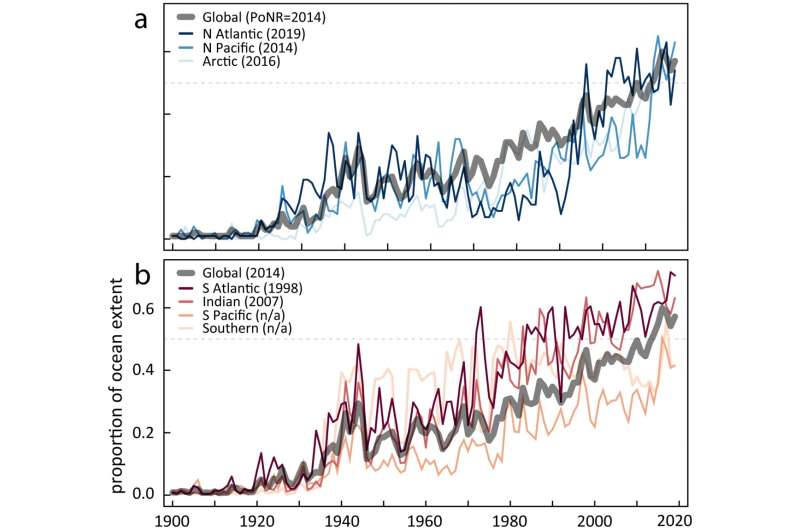Study finds extreme heat is the 'new normal' for the ocean

New Monterey Bay Aquarium-led research reveals excessively warm ocean temperatures driven by climate change are the new normal. The study, published today by PLOS Climate, establishes that more than half of the ocean surface has exceeded a historical heat extreme threshold on a regular basis since 2014.
And it is these heat extremes, researchers say, that increase the risk of collapse for crucial marine ecosystems, including coral reefs, seagrass meadows, and kelp forests —altering their structure and function, and threatening their capacity to continue to provide life-sustaining services to human communities.
Researchers conducted the study by mapping 150 years of sea surface temperatures to determine a fixed historical benchmark for marine heat extremes. The scientists then looked at how often and how much of the ocean surpassed this point. The first year in which more than half of the ocean experienced heat extremes was 2014. The trend continued in subsequent years, reaching 57 percent of the ocean in 2019, the last year measured in the study. Using this benchmark, just two percent of the ocean surface was experiencing extremely warm temperatures at the end of the 19th century.
"Climate change is not a future event," said Dr. Kyle Van Houtan, who headed the research team during his tenure as chief scientist for the aquarium. "The reality is that it's been affecting us for a while. Our research shows that for the last seven years more than half of the ocean has experienced extreme heat."
"These dramatic changes we've recorded in the ocean are yet another piece of evidence that should be a wake-up call to act on climate change," he added." We are experiencing it now, and it is speeding up."
The study grew from separate research into the history of kelp forest changes throughout California. Van Houtan and team discovered that sea surface heat extremes, which are key stressors for canopy kelps, needed to be quantified and mapped along the California coast throughout the last century. The researchers then decided to expand the investigation beyond California to better understand the long-term frequency and location of extreme marine heat across the global ocean surface.
Using historic records, aquarium scientists first determined the average temperatures for the ocean's surface over the period spanning 1870 to 1919. Then they identified the most dramatic ocean warming that occurred during that period—the top two percent of temperature increases—and defined that as "extreme heat." The team then mapped the extremes over time, examining whether they occur regularly or are becoming more frequent.
"Today, the majority of the ocean's surface has warmed to temperatures that only a century ago occurred as rare, once-in-50-year extreme warming events," Van Houtan said.
The researchers say the new normal of extreme heat across the majority of the ocean's surface is further evidence for the urgent need to drastically reduce emissions from the burning of fossil fuels, which are the driver of climate change.
"When marine ecosystems near the tropics experience intolerably high temperatures, key organisms such as corals, seagrass meadows, or kelp forests can collapse," Van Houtan said. "Altering ecosystem structure and function threatens their capacity to provide life-sustaining services to human communities like supporting healthy and sustainable fisheries, buffering low-lying coastal regions from extreme weather events, and serving as a carbon sink to store the excess carbon put in the atmosphere from human-generated greenhouse emissions."
More information: The recent normalization of historical marine heat extremes, PLOS Climate, journals.plos.org/climate/arti … journal.pclm.0000007
Journal information: PLOS Climate
Provided by Monterey Bay Aquarium





















